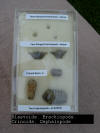DJK
Office
Phone: (319)
338-3092
Home Phone: (319) 354-7383
Email: Sales@DaveKreiter.com
Fossil Collection
In the autumn of 2000, my friend Susan and I were taking a walk on a scenic trail near Iowa City. It was supposed to be a brisk walk, but I found myself stopping intermittently, waiting for Susan, as she bent over to pick up various rocks alongside the trail. She told me that as a kid she spent many hours with her family “editing” the ground for fossils, rocks, and minerals.
Several years earlier, in 1993, the cities of Iowa City and surrounding communities experienced a 100 year flood. The Coralville Reservoir Dam was breached, and the water that escaped over the dam overflow washed away tons of top soil exposing the fossil laden layers below. An outdoor museum of sorts was soon established at the overflow site for visitors and tourists to explore the fossil rick rocks. I discovered that these layers were formed during the Devonian Period nearly 365 million years ago. These two incidences, the flood, and my friend’s interest in rocks, piqued my own curiosity. I suggested to Susan that we make a hobby out of our mutual interest.
The Coralville lake area is rich in exposed Devonian fossils and our kayaking hobby provided a vehicle to explore the hundreds of inlets around the lake. Soon we had amassed a variety of fossils, and we began to check out paleontology books from our local library to help identify and categorize our finds. By the next year, we started to investigate other sites in Iowa and Wisconsin. With the help of bedrock geology maps, we were able to ascertain the age of the rocks and the fossils they contained. Soon we joined MAPS (Mid America Paleontology Society) and went on fossil field trips with the club to various quarries round the area where we discovered more fossil varieties. Our collections grew fairly quickly over the next decade. Below are some of the fossils I collected and have displayed. Click on the caption below any of the images to enlarge the image and start a slide show. You may also stop the slide show and use the left and right arrow indicators to move through the slides manually. If you have a low resolution screen you may not see the navigation arrows. In that case, you will need to just click on the picture to move manually through the pictures.






















